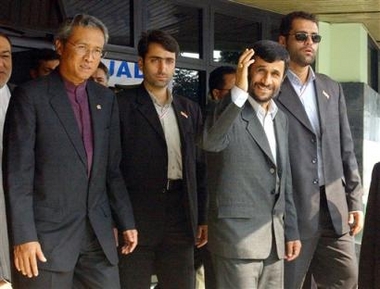U.N. inspectors have found traces of highly enriched uranium on equipment
from an Iranian research center linked to the military, diplomats said Friday,
revelation likely to strengthen U.S. arguments that Tehran wants to develop
nuclear arms.

Iranian President
Mahmoud Ahmadinejad waves to journalists as he walks with Indonesian
Minister of Research and Technology Kusmayanto Kadiman, left, after
meeting with Indonesia's second largest Muslim organization Muhammadiyah
in Jakarta, Indonesia, Friday, May 12, 2006. The Iranian president told a
meeting of Indonesian Islamic leaders his country's nuclear program is for
peaceful purposes, participants in discussion said.
[AP] |
The diplomats, who demanded anonymity in exchange for divulging the
confidential information, cautioned that confirmation still had to come through
other laboratory tests.
Initially, they said the density of enrichment appeared to be close to or
above the level used to make nuclear warheads. But later a diplomat accredited
to the International Atomic Energy Agency said it was below that, although
higher than the low-enriched material used to generate power and heading toward
weapons-grade level.
Still, they said, further analysis could show that the find matches others
established to have come from abroad. The IAEA determined earlier traces of
highly enriched uranium were imported on equipment from Pakistan that Iran
bought on the black market during nearly two decades of clandestine activity.
Even then, nevertheless, the find would be significant.
Because Iran has previously denied conducting enrichment-related activities
at the site, the mere fact the traces came from there bolsters arguments that it
has hidden parts of a program that can create the fissile material used in
nuclear warheads. Additionally, the site's connection to the military weakens
Iranian arguments that its nuclear program is purely civilian.
"That has long been suspected as the site of undeclared enrichment research
and ... the Iranians have denied that any enrichment research had taken place at
that location," said Iran expert Gary Samore of the MacArthur Foundation in
Chicago. "It certainly does reinforce the agency's suspicion that Iran has not
fully declared its past enrichment research."
The development, however, was unlikely to result in an immediate American
push for strong U.N. Security Council action against Tehran.
The Americans recently agreed to put such efforts on hold and give new
European-led attempts to find a negotiated solution a chance in the face of
fierce Russian and Chinese opposition to a strong signal from the council.
Moscow and Beijing have balked at British, French and U.S. efforts to put a
Security Council resolution under Chapter 7 of the U.N. Charter. Such a move
would declare Iran a threat to international peace and security and set the
stage for further measures if Tehran refuses to suspend uranium enrichment.
Those measures could range from breaking diplomatic relations to economic
sanctions and military action.
Despite their declared support for the European effort to persuade Iran to
give up enrichment, the Americans are ignoring calls for direct contacts with
Iran ¡ª a stance criticized Friday by U.N. Secretary-General Kofi Annan.
Calling on "all sides to lower the rhetoric," Annan said Washington should
"come to the table" and join the Europeans and Iranians.
Iran's president remained defiant. He accused the Americans of "waging a
propaganda campaign" against his country. "The people of Iran and the country
are not afraid of them," President Mahmoud Ahmadinejad told Islamic leaders in
Indonesia.
On Saturday, Ahmadinejad reiterated that his aim was to generate energy, and
that he would continue to fight for the right to develop new technologies. He
spoke ahead of trade talks between the so-called Developing Eight nations.
Uranium enriched to between 3.5 percent and 5 percent is used to make fuel
for reactors to generate electricity. It becomes suitable for use in nuclear
weapons when enriched to more than 90 percent.
Iran denies it wants to make nuclear arms and says it is interested in
uranium only to generate power. It already has enriched uranium to low levels ¡ª
an accomplishment that opens the pathway to weapons-grade enrichment.
Diplomats accredited to the IAEA on Friday noted that Tehran's enrichment
program has progressed faster than agency experts had expected. That also
suggests Iran has hidden research and development from IAEA inspectors, they
said.
To argue that it never produced highly enriched uranium domestically, Tehran
cites the IAEA's tentative conclusion last year that traces collected from
Iranian sites with no suspected ties to the military arrived on equipment from
Pakistan.
But the origin of the samples now being studied created some concern in that
regard.
One of the diplomats told The Associated Press that the samples came from
vacuum pumps that has various applications, including use in uranium-enriching
centrifuges at a former research center at Lavizan-Shian. The center is believed
to have been the repository of equipment bought by the Iranian military that
could be used in a nuclear weapons program.
The United States alleges Iran conducted high-explosive tests that could have
a bearing on developing nuclear weapons at the site.
The State Department said in 2004 that Lavizan's buildings had been
dismantled and topsoil removed to hide nuclear weapons-related experiments. The
IAEA later confirmed the site had been razed.
In an April 28 report, IAEA head Mohamed ElBaradei said the agency took
samples from some of the equipment of the former Physics Research Center at
Lavizan-Shian.